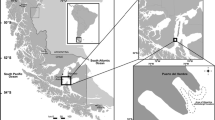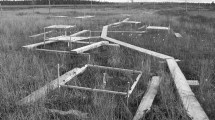Abstract
Elysia tuca Marcus were collected from the Florida Keys (USA) during 1978–1979, with the aim of clarifying the physiological significance of their kleptoplastids by studying variations in the chlorophyll content of the slugs. The chlorophyll levels in the field populations varied seasonally, with peak levels in autumn. Peak reproductive activity coincided with maximum chlorophyll levels, carbon fixation, and rate of macromolecular conversion of kleptoplastid (= “symbiotic chloroplast”) photosynthates. Changes in chlorophyll level are probably controlled by rate of feeding, which is in turn governed by such factors as algal density and climatic factors (light and temperature). Chlorophyll level and individual weight varied with location, with significant differences between sites in the Upper Keys and the Lower Keys. Environmental factors control benefits of kleptoplastid retention, and suggest that photosynthate yield is an important subsidy of reproductive output.
Similar content being viewed by others
Literature cited
Bach, S. D.: Standing crop, growth and production of calcareous siphonales (Chlorophyta) in a south Florida lagoon. Bull. mar. Sci. 29, 191–201 (1979)
Bohm, E. L.: Studies on the mineral content of calcareous algae. Bull. mar. Sci. 23, 177–190 (1973)
Brandley, B. K.: Aspects of the ecology and physiology of Elysia cf. furvacauda (Mollusca: Sacoglossa). Bull. mar. Sci. 34, 207–219 (1984)
Clark, K. B.: Construction of a collecting device for small aquatic organisms and a method for rapid weighing of small invertebrates. Veliger 13, 364–367 (1971)
Clark, K. B.: Nudibranch life cycles in the northwest Atlantic and their relationship to the ecology of fouling communities. Helgoländer. wiss. Meeresunters. 27, 28–69 (1975)
Clark, K. B.: Correction: development of Elysia subornata is not poecilogonous. J. mollusc. Stud. (1986). (In press)
Clark, K. B. and M. Busacca: Feeding specificity and chloroplast retention in four tropical Ascoglossa, with a discussion of the extent of chloroplast symbiosis and the evolution of the order. J. mollusc. Stud. 44, 272–282 (1978)
Clark, K. B., M. Busacca and H. M. Stirts: Nutritional aspects of development of the ascoglossan Elysia cauze. In: Reproductive ecology of marine invertebrates, pp 11–14 Ed. by S. E. Stancyk. Columbia: University of S. Carolina Press 1979
Clark, K. B. and K. R. Jensen: A comparison of egg size, capsule size, and development patterns in the order Ascoglossa (Sacoglossa) (Mollusca: Opisthobranchia). Int. J. Invertebrate Reprod. (Amsterdam) 3, 57–64 (1981)
Clark, K. B., K. R. Jensen, H. M. Stirts and C. Fermin: Chloroplast symbiosis in a non-elysiid mollusc, Costasiella lilianae (Marcus) (Hermaeidae: Ascoglossa) (= Sacoglossa): effects of temperature, light intensity and starvation on carbon fixation rate. Biol. Bull. mar. biol. Lab., Woods Hole 160, 43–54 (1981)
Goetzfried, A.: A comparison of light dependence of photosynthesis in a sacoglossan Elysia tuca and its algal food Halimeda discoidea, 43 pp. M.S. thesis, Florida Institute of Technology, Melbourne, USA 1977
Hadzi, J.: The evolution of the Metazoa, 499 pp. New York: Pergamon Press 1963
Hinde, R.: Chloroplast “symbiosis” in sacoglossan molluscs. In: Endocytobiology endosymbiosis and cell biology, pp 729–736. Ed. by W. Schwemmler and H. E. A. Schenk. Berlin: De Gruyter & Co. 1980
Hinde, R. and D. C. Smith: “Chloroplast symbiosis” and the extent to which it occurs in Sacoglossa (Gastropoda: Mollusca). Biol. J. Linn. Soc. 6, 349–356 (1974)
Jensen, K. R.: A review of sacoglossan diets, with comparative notes on radular and buccal anatomy. Malac. Rev. 13, 55–77 (1980)
Jensen, K. R. and K. B. Clark: Annotated checklist of Florida ascoglossan Opisthobranchia. Natilus 97, 1–13 (1983)
McLean, N.: Phagocytosis of chloroplasts in Placida dendritica (Gastropoda: Sacoglossa). J. exp. Zool. 197, 321–330 (1976)
Menzel, D.: Plug formation and peroxidase accumulation in two orders of siphonous green algae (Caulerpales and Dasycladales) in relation to fertilization and injury. Phycologia 19, 37–48 (1980)
Stirts, H. M. and K. B. Clark: Effects of temperature on products of symbiotic chloroplasts in Elysia tuca Marcus (Opisthobranchia: Sacoglossa). J. exp. mar. Biol. Ecol. 43, 39–47 (1980)
Strain, H. H. and W. A. Svec: Extraction, separation, estimation, and isolation of the chlorophylls. In: The chlorophylls, pp 21–66. Ed. by L. P. Vermon and G. R. Selly. New York: Academic Press, 1966
Switzer-Dunlap, M.: Symbiosis between algal chloroplasts and the moluse Placobranchus ocellatus van Hasselt, 167 pp. Ph.D. dissertation, University of Hawaii 1975
Thompson, D. M.: A histological and ultrastructural investigation of the development of chloroplasts symbiotic in Elysia subornata juveniles (Opisthobranchia: Ascoglossa). 80 pp. M.S. thesis. Florida Institute of Technology, Melbourne, USA 1982
Trench, R. K.: Of “leaves that crawl”: functional chloroplasts in animal cells. Symp. Soc. exp. Biol. 29, 229–265 (1975)
Trench, R. K.: Uptake retention and function of chloroplasts in animal cells. In: Endocytobiology endosymbiosis and cell biology. pp 703–727. Ed. by W. Schwemmler and H.E. A. Schenk. Berlin: De Gruyter & Co 1980
Weaver, S. and K. B. Clark: Light intensity preference of five ascoglossan (= sacoglossan) molluscs (Gastropoda: Opisthobranchia): a comparison of chloroplast-symbiotic and aposymbiotic species. J. mar. Behav. Physiol. 7, 297–306 (1981)
Wilbur, K. M., L. H. Colinvaux and N. Watabe: Electron microscope study of calcification in the alga Halimeda (order Siphonales). Phycologia 8, 27–35 (1969)
Author information
Authors and Affiliations
Additional information
Communicated by J. M. Lawrence, Tampa
Rights and permissions
About this article
Cite this article
Waugh, G.R., Clark, K.B. Seasonal and geographic variation in chlorophyll level of Elysia tuca (Ascoglossa: Opisthobranchia). Mar. Biol. 92, 483–487 (1986). https://doi.org/10.1007/BF00392508
Accepted:
Issue Date:
DOI: https://doi.org/10.1007/BF00392508




